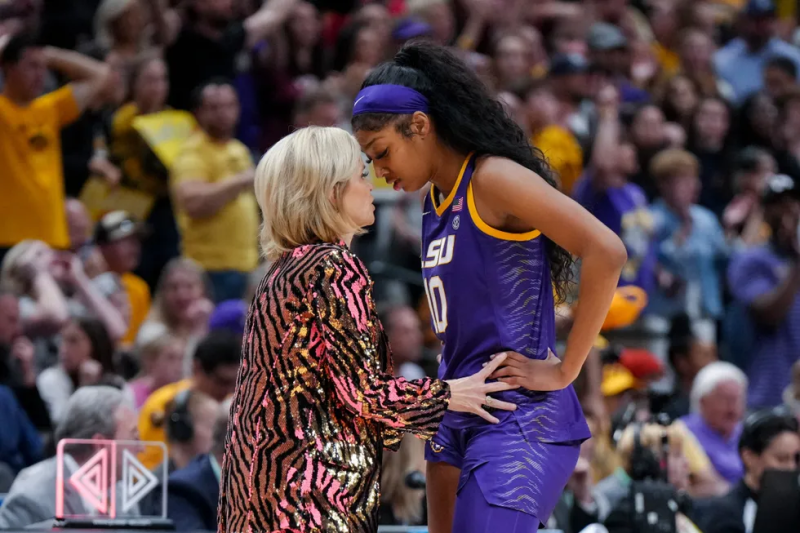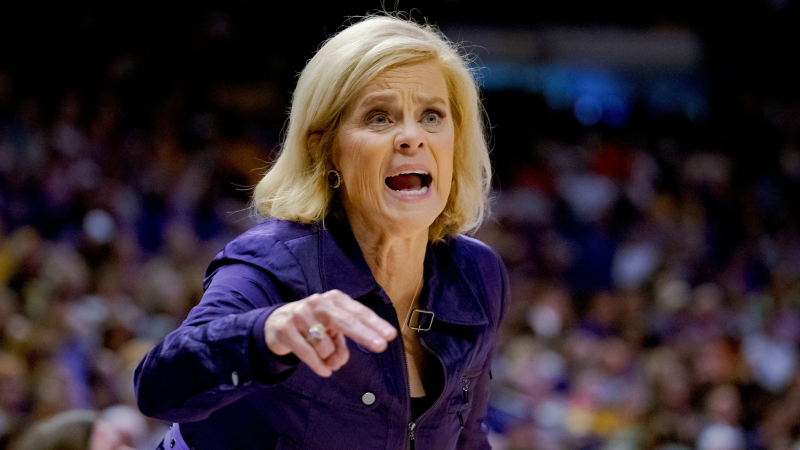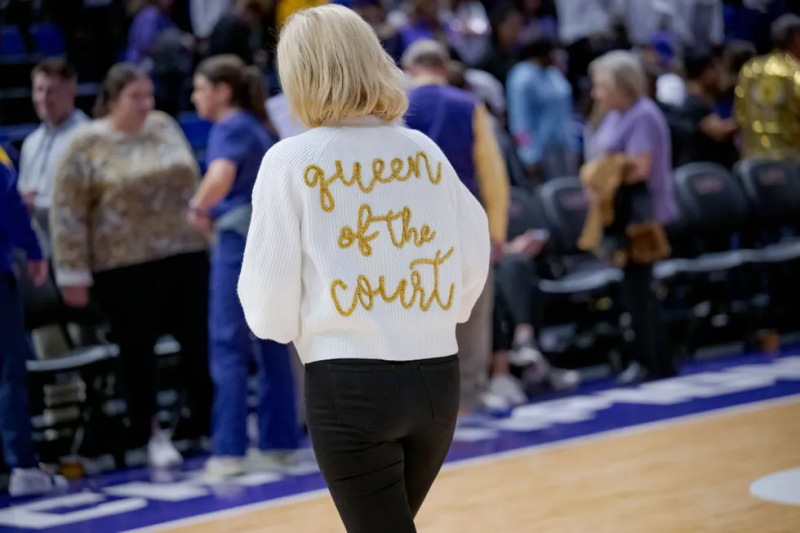LSU's investment in Kim Mulkey has her atop women's college basketball coaches pay list
BATON ROUGE, La. — When Kim Mulkey left the women’s basketball powerhouse at Baylor in April 2021 to take the job at LSU, the fiery Louisiana native earned a new nickname: R-O-I.
As in, “return on investment,” what ESPN analyst Debbie Antonelli expected when the Tigers persuaded Mulkey, who’d won three national championships at Baylor, to return to her home state, making her the highest-paid coach in women’s hoops. LSU athletics director Scott Woodward said he knew it would be money well spent, but could anyone have predicted this?
In USA TODAY Sports’ review of compensation for Division I women’s basketball head coaches, Mulkey is the highest paid at $3.26 million this season, edging South Carolina’s Dawn Staley and Connecticut's Geno Auriemma, who both make $3.1 million. She is one of 18 coaches making $1 million or more this year, an uptick from 11 since USA TODAY Sports last did this investigation in 2021-22.
The spike in “million-dollar babies,” as one agent likes to call them, speaks to the exponential rise in both investment in women’s sports and their popularity. And while women’s coaches say there are still significant improvements to be made, the numbers from LSU’s annual financial report back up what many have been arguing for years: It takes money to bring in more money.
To wit:
WOMEN'S BRACKET MADNESS: Enter USA TODAY's women's tournament bracket contest for a chance at $1 million prize.
- In the three seasons before Mulkey arrived in Baton Rouge — not including 2020-21, which was a weird year for every program because of the COVID-19 pandemic — operating revenue from LSU women’s basketball averaged just over $306,000 per year. In Mulkey’s first season, 2021-22, revenue totaled nearly $1.8 million. In 2022-23, it was nearly $2.5 million. Like many schools, LSU attributes none of its media rights revenue to women’s basketball, although for fiscal 2023 it reported $27 million of its $46.3 million in media rights revenue as being not specific to any one sport.
- From 2017-2020, LSU reported $316,213 from ticket sales. In 2021-22, it was $867,166. Last season, it was $973,880. And for 2024, LSU's average attendance is substantially larger as the Tigers have drawn five-figure crowds almost exclusively.
- Money that LSU categorized as contributions to the women's basketball program has quadrupled under Mulkey. In 2019-20, the year before the pandemic, it was $200,021. In 2020-21, it was $32,250. In 2021-22, it was $583,586. In 2022-23, it was $836,939.
And that’s before the Tigers won the 2023 national championship behind Angel Reese, a player Mulkey picked up in the transfer portal in 2022 as one of her first moves as head coach.
“I call it Mulkey Mania,” Antonelli told USA TODAY Sports of the Tigers craze, where locals pack Pete Maravich Assembly Center, many of them in sequin jackets matching the head coach’s gaudy attire. “I credit Scott Woodward. He paid her a big, fat salary, he invested in the infrastructure and knew she would deliver. It’s remarkable what they’ve done. But probably even he didn’t know it was going to be this good this quickly.”
It’s proof, Antonelli added, that when athletics departments invest in women’s sports, the return is worth it.
AD supporting his alma mater, 'financials be damned'
To be clear, Woodward said he still expects LSU to run “a massive deficit” in women’s basketball this season. It’ll likely be similar to last season’s operating deficit, which checked in at just under $7.8 million. In 2020, it was $4.35 million.
Woodward doesn’t care. He doesn’t think investing in women’s sports should be measured objectively, but rather subjectively. A 1985 LSU grad, he said he is driven by the desire to have his school considered the best in everything, whether it’s football, physics or yes, women’s hoops.
“I’m looking at it for the greater good — not just for women’s sports but for young girls in this community and people who aspire to come to this university and for making people feel great in this state,” he said. “I don’t look at it as dollars and cents or red and black.”

Because of that, Woodward plans to keep spending money on women’s basketball, “financials be damned.”
In the NCAA’s current model, schools get almost their entire operating budget from the revenue brought in by football and men’s basketball (LSU also came close to breaking even in baseball according to its fiscal year financial report from 2022-23, which is unusual). But there’s hope from the women’s basketball community that soon, their sport will be a money-maker, too.
In January, the NCAA announced an eight-year, $290 million media rights deal for 40 NCAA championship events, headlined by women’s basketball. The deal, which goes into effect next season, is worth roughly triple the current agreement. Additionally, new NCAA president Charlie Baker announced that women’s basketball, like its male counterpart, will start to receive units, where conferences get paid for making the NCAA Tournament and advancing.
The men have had units — which coaches say encourage schools to invest in men’s hoops — for more than three decades. Women’s coaches have been fighting for nearly a decade for the same distribution model. It’ll be a boon for everyone, but especially schools that typically dance deep into March.
Mulkey isn’t sure if women’s basketball can become a cash cow, though.
“Will it happen in my lifetime? I don’t know,” she said to USA TODAY Sports. “I hope so. I certainly have seen a lot in my lifetime that I never thought I’d see in women’s basketball: we are on television just about every game.”
David Berri, a sports economics professor at Southern Utah University, is optimistic that women's sports can and will generate more money in the coming years. But there are factors out of their control, too.
“It’s still going to be the case that women’s college basketball is going to lag in revenue compared to men’s,” Berri said. “And it’s not because the men’s product is better, it’s because they came first and have 100 years of history (and marketing) behind them.”

'I think Kim Mulkey is a genius'
A major issue when it comes to women’s sports making profit relates to television.
“One of the things that holds back women’s sports is the TV deals people make for them, they’re really lousy,” Berri explained. “In women’s basketball, one (of the) things that holds back women’s revenue is the NCAA is run by men, who don’t try very hard” to sell women’s sports.
Woodward has no idea how quickly women’s basketball could become profitable nationwide but said “the signs are good,” in terms of TV ratings and ticket sales. Last April, the LSU-Iowa final drew nearly 10 million viewers, a 103% increase from the 2022 championship game. This season, numerous TV viewing records have been set, and sellouts have become more common in some Power Five conferences.
Mulkey, too, is encouraged that the power and potential of women’s sports is “acknowledged now in a way that’s not forced and not fake,” she said. “The crowds around buses when you go on a road trip, the lines outside arenas to get into ball games, that’s real stuff. We just don’t have enough of those (programs) yet.”
It’s still going to be the case that women’s college basketball is going to lag in revenue compared to men’s. And it’s not because the men’s product is better, it’s because they came first and have 100 years of history (and marketing) behind them.David Berri, sports economics professor at Southern Utah University
But because of what LSU has done, other schools believe they can get there, too.
“I think Kim Mulkey is a genius,” said Arizona coach Adia Barnes. “She started this whole fad where they dress like her and look what she’s done in such a short amount of time, look how many fans they bring. It’s pretty remarkable.”
When Barnes took over at Arizona in 2016, the Wildcats had just over 300 season ticket holders. After leading the Wildcats to the 2021 Final Four, the McKale Center is regularly packed; Arizona leads the Pac-12 in attendance, at 7,569 fans per game. Arizona sold more than 7,000 season tickets this year and during Barnes’ eight-year tenure, has raised season ticket prices three times.
“All the great players, all the stardom across women’s basketball, that’s powerful,” Barnes said. “And it leads to finances.”
LSU is paying Kim Mulkey more than its men's hoops coach this season
Mulkey said when Woodward recruited her, she didn’t demand a certain salary for herself or assistants.
“I never put a dollar figure on anything (during negotiations),” said Mulkey, who was surprised to learn she is the highest-paid coach in women’s hoops this season. “What I did ask was, ‘Are you making a financial investment? I need to tell you what I make at Baylor. Are you saying that you want to hire me and my staff with the understanding that we’re not taking a pay cut?’ ”
The answer was a resounding “yes.” Baylor, which Mulkey said “took good care of me financially,” had already made her one of the highest-paid women's head coaches in the country during her 21 seasons in Waco; in her last full calendar year at Baylor (2020), the school credited her with $2.7 million, including the value of bonuses and benefits, according to tax documents. Mulkey took two of her three assistants to Baton Rouge, and has since expanded her support staff. Also, in 2022 she brought in veteran assistant Bob Starkey, who has coached both the LSU men's and women’s teams for 24 seasons combined.

Spending on women’s hoops in Baton Rouge has increased significantly since Mulkey arrived. In fiscal year 2022, LSU invested $8.3 million, compared to a little over $4.3 million in fiscal year 2021. In fiscal year 2023, LSU spent $10.25 million, almost as much as it did on men’s ($10.7 million). Mulkey’s pay is higher this season than that of Tigers men’s coach Matt McMahon, who makes $2.7 million in his second season. In fiscal year 2023, the biggest gap was in support staff funds, where the school spent $570,000 more for women's basketball than it did for men's.
Mulkey said she didn’t know the spending breakdown, and wasn’t concerned about it.
“I’m not a big person who compares,” she said, shrugging.
Still, Mulkey and Woodward understand that LSU is setting a precedent other programs want their schools to follow.
“I’ve had that conversation: ‘Coach, tell me how I can get our administration to give us what you’re getting?’ Listen, I’m a realist: a lot of that has to do with, I have skins on the wall,” Mulkey said, referencing her four national championships. “And some of these coaches don’t. So I think they will listen to me because of what I’ve done throughout my career. There’s respect there.”
Kim Mulkey hopes other schools follow her example
Mulkey knows she has a national reputation for being prickly, though she’s adored throughout Baton Rouge and within the LSU athletics department. (She’s deeply respected, too, evident by the fact that it’s her, and not McMahon, who has the best, and closest, parking spot at Pete Maravich Assembly Hall. “It’s probably about seniority,” she joked. “I’m the oldest, so they think I need to walk the shortest distance.”)
She said her aim is never to be high maintenance. But she admits, “I’m a coach who’s going to keep you on your toes. I demand excellence, and don’t take no for an answer. If ‘no’ is gonna be your answer, I’m gonna say, ‘Tell me how and why and let’s figure out how to say 'yes.' I always believe there’s a way to do things. It’s easy and simple to say 'no'; I want somebody to say, ‘Hey that’s a great idea. Let’s figure out how to do that even if we’ve never done that before.’ ”
An example of marketing Mulkey doesn't like: across women’s basketball, numerous programs give away hundreds of tickets, or do something gimmicky — pizza coupons, free T-shirts — to get fans to attend games.
Her philosophy is different: Recruit good players, win games and put a product on the floor that sells itself. Trust that you and your players have worth right now.
Women’s basketball is valuable, Mulkey said — and that should be more evident now than ever before.
Email Lindsay Schnell at lschnell@usatoday.com or follow her on social media @Lindsay_Schnell and Steve Berkowitz at sberkowi@usatoday.com or @ByBerkowitz
Disclaimer: The copyright of this article belongs to the original author. Reposting this article is solely for the purpose of information dissemination and does not constitute any investment advice. If there is any infringement, please contact us immediately. We will make corrections or deletions as necessary. Thank you.







